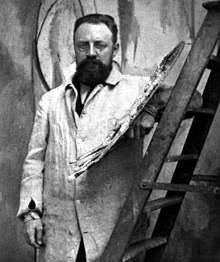Henri Matisse
| Henri Matisse | |
|---|---|

Henri Matisse, 1913, by Alvin Langdon Coburn
|
|
| Born |
Henri-Émile-Benoît Matisse 31 December 1869 Le Cateau-Cambrésis, Nord, France |
| Died | 3 November 1954 (aged 84) Nice, Alpes-Maritimes, France |
| Nationality | French |
| Education | Académie Julian, William-Adolphe Bouguereau, Gustave Moreau |
| Known for | Painting, printmaking, sculpture, drawing, collage |
| Notable work | Woman with a Hat, 1905, Nu bleu, 1907, La Danse, 1909 |
| Movement | Fauvism, Modernism, Post-Impressionism |
| Patron(s) | Gertrude Stein, Etta Cone, Claribel Cone, Sarah Stein, Albert C. Barnes |
Henri-Émile-Benoît Matisse (French: [ɑ̃ʁi emil bənwɑ matis]; 31 December 1869 – 3 November 1954) was a French artist, known for both his use of colour and his fluid and original draughtsmanship. He was a draughtsman, printmaker, and sculptor, but is known primarily as a painter.
Matisse is commonly regarded, along with Pablo Picasso as one of the artists who best helped to define the revolutionary developments in the visual arts throughout the opening decades of the twentieth century, responsible for significant developments in painting and sculpture. Although he was initially labelled a Fauve (wild beast), by the 1920s he was increasingly hailed as an upholder of the classical tradition in French painting. His mastery of the expressive language of colour and drawing, displayed in a body of work spanning over a half-century, won him recognition as a leading figure in modern art.
Matisse was born in Le Cateau-Cambrésis, in the Nord department in northern France, the oldest son of a prosperous grain merchant. He grew up in Bohain-en-Vermandois, Picardie, France. In 1887 he went to Paris to study law, working as a court administrator in Le Cateau-Cambrésis after gaining his qualification. He first started to paint in 1889, after his mother brought him art supplies during a period of convalescence following an attack of appendicitis. He discovered "a kind of paradise" as he later described it, and decided to become an artist, deeply disappointing his father.
In 1891 he returned to Paris to study art at the Académie Julian and became a student of William-Adolphe Bouguereau and Gustave Moreau. Initially he painted still lifes and landscapes in a traditional style, at which he achieved reasonable proficiency. Matisse was influenced by the works of earlier masters such as Jean-Baptiste-Siméon Chardin, Nicolas Poussin, and Antoine Watteau, as well as by modern artists, such as Édouard Manet, and by Japanese art. Chardin was one of the painters Matisse most admired; as an art student he made copies of four of Chardin's paintings in the Louvre.
...
Wikipedia
